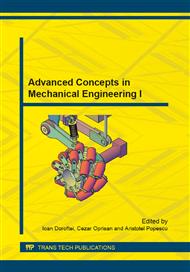p.35
p.41
p.47
p.55
p.59
p.65
p.71
p.77
p.83
Naval Centrifugal Compressor Design Using CAD Solutions
Abstract:
Centrifugal compressors of turbochargers operate in a wide range of rotational speeds, which depends on the load of the supercharged engine. Current designs of turbocharger compressors exhibit high efficiencies accompanied by high flow capacities [1]. Consequences of aerodynamic optimization are high mean stress values in the blades due to centrifugal loading as well as dynamic stresses due to blade vibrations. Blade vibrations in a turbocharger compressor are assumed to be predominantly excited by unsteady aerodynamic forces [2]. These forces are caused by a variety of sources influencing the flow. Examples include the geometry of the flow channel, elbows, the diffuser vanes or struts. Therefore, an understanding of FSI is essential for further design optimizations.
Info:
Periodical:
Pages:
59-64
Citation:
Online since:
October 2014
Authors:
Price:
Сopyright:
© 2014 Trans Tech Publications Ltd. All Rights Reserved
Share:
Citation:


